Experimental and Numerical Research on a Pipe Element Passing through Bulkhead with Symmetrical Elastic Installation
Abstract
:1. Introduction
2. Design of Pipe Element Passing through Bulkhead with Symmetrical Elastic Installation
3. Test Bench and Study Description
4. Results and Discussion
4.1. Finite Element Modeling
4.1.1. Intensity Analysis
4.1.2. Modal Analysis
4.2. Harmonic Response Analysis of Different Direction of Excitation
4.2.1. Harmonic Response Analysis during Radial Excitation
4.2.2. Harmonic Response Analysis during Axial Excitation
4.3. Vibration Damping Performance Analysis
4.3.1. The Vibration Damping Performance of Pipe Element Passing through Bulkhead
4.3.2. The Vibration Damping Performance of Different Symmetrical Measuring Points
4.3.3. The Vibration Damping Performance of Different Temperature Environments
5. Conclusions
- (1)
- Compared with the rigid installation, after adding the EMWM materials, the overall vibration damping performance of the structure is obvious. The maximum average insertion loss of each direction is 25.4 dB. At the same time, the resonant frequency and resonance peak of a pipe element passing through a bulkhead with a symmetrical elastic installation is significantly reduced.
- (2)
- A pipe element passing through a bulkhead with symmetrical elastic installation has a better vibration isolation effect in the full frequency band of 5 to 2000 Hz. The maximum insertion loss is 23.4 dB. At different temperatures and different excitation directions, the insertion loss can reach more than 12 dB.
- (3)
- The excitation direction has a great influence on the vibration damping performance of a pipe element passing through a bulkhead with symmetrical elastic installation. The vibration damping performance under a radial load is better than that of the axial load, and the insertion loss difference can be up to about 10 dB.
- (4)
- The vibration characteristics of a pipe element passing through a bulkhead with symmetrical elastic installation are less affected by ambient temperature. It can maintain good vibration damping performance in a wide temperature range.
Author Contributions
Funding
Institutional Review Board Statement
Informed Consent Statement
Data Availability Statement
Conflicts of Interest
References
- Sotoodeh, K. A review on subsea process and valve technology. Mar. Syst. Ocean Technol. 2019, 14, 210–219. [Google Scholar] [CrossRef]
- Kim, T.Y.; Yoon, S.W.; Cho, J.H.; Kim, Y.H.; Kim, M.H. Vibration characteristics of filament wound composite tubes applied to the intermediate shaft in ship propulsion system. Mod. Phys. Lett. B 2019, 33, 1940029. [Google Scholar] [CrossRef]
- Wang, G.Z.; Liu, Y.H. Virtual design of monitoring and forecasting system of ship’s under water noise. Noise Vib. Control 2009, 29, 6–10. [Google Scholar]
- Matuszewski, L. Application of Shape Memory Alloys in Pipeline Couplings for Shipbuilding. Pol. Marit. Res. 2020, 27, 82–88. [Google Scholar] [CrossRef]
- Li, Z.; Tang, Y.; Tang, F.; Chen, Y.; Chen, G. Elastic buckling of thin-walled polyhedral pipe liners encased in a circular pipe under uniform external pressure. Thin Wall Struct. 2017, 123, 214–221. [Google Scholar] [CrossRef]
- Wang, J.; Shuai, Y.; Feng, C.; Zhang, P.; Wang, T.; Lin, N.; Liu, Z. Multi-dimensional mechanical response of multiple longitudinally aligned dents on pipelines and its effect on pipe integrity. Thin Wall Struct. 2021, 166, 108020. [Google Scholar] [CrossRef]
- Pratiwi, E.; Artana, K.B.; Dinariyana, A. Ship Collision Frequency during Pipeline Decommissioning Process on Surabaya West Access Channel (SWAC). J. Eng. Sci. Technol. 2019, 14, 2013–2033. [Google Scholar]
- Cheng, H.; Pinheiro, B.C.; Estefen, S.F.; Xu, L.; Paz, C.M.; Duan, M. Ultimate bending strength of sandwich pipes with actual interlayer behavior. Thin Wall Struct. 2021, 161, 107476. [Google Scholar] [CrossRef]
- Jiao, X. Heat-Solid Coupling Analysis of the Cooling Water Jacket of the Through-Cabin Fitting; Harbin University of Engineering: Harbin, China, 2013. [Google Scholar]
- Peng, Y.F.; He, H.Y.; Li, S.; Yu, J. Research on the vibration reduction mechanism of elastic pipe penetration piece and simulation. Ship Sci. Technol. 2011, 33, 119–122. [Google Scholar]
- Yin, X.Q.; Jin, X.; Liu, T.G. Analysis of technology property for pipe element passing through bulkhead with elasticity. Ship Eng. 2010, 1, 112–116. [Google Scholar]
- Pan, G.X.; Jing, H.S.; Liu, T.G. Experiment for influence to vibration isolation of deviation in mounting on pipe element passing through bulkhead with elasticity. Ship Sci. Technol. 2011, 33, 48–54. [Google Scholar]
- Jing, H.S.; Hu, Y.; Liu, T.G. Simulation analysis on vibration isolation of elastic pipe element passing through bulkhead with mounting deviation. Ship Ocean Eng. 2011, 40, 24–25. [Google Scholar]
- Hu, D.F.; Jin, X.; Liu, T.G.; Zhou, C.Q. Design of pipe element passing through bulkhead with elastic installation. Shipbuild. China 2011, 52, 146–153. [Google Scholar]
- Shen, Z.F.; Wu, S.M.; Zhang, Y.; Zhou, Z.J. Research and design of pipe penetration piece with damping based on FEM. Ship Sci. Technol. 2013, 35, 73–77. [Google Scholar]
- Li, G.L. The Cooling and Vibration Attenuation Design of the High Temperature and High Pressure Pipe Penetration Piece; Harbin University of Engineering: Harbin, China, 2012. [Google Scholar]
- Qiu, D.L. Dynamic Analysis of the Ship Pipes System; Harbin University of Engineering: Harbin, China, 2013. [Google Scholar]
- Xiong, J.Y. The Design and Test Study of Elastic Wearing Compartment Vibration Device; Huazhong University of Science and Technology: Wuhan, China, 2019. [Google Scholar]
- Chen, G.F.; Li, W.; Wang, B.; Li, P. Research on vibration isolation and sealing technology for flexible piping penetration. Ship Sci. Technol. 2020, 42, 68–70. [Google Scholar]
- Li, J.W. Research on Periodic Active Constraint Layer Damping Treatment of Pipeline System; Dalian University of Technology: Dalian, China, 2020. [Google Scholar]
- Chapnik, B.; Currie, I.G. Noise reduction using finite-length flexible segments. J. Vib. Acoust. 2000, 122, 94–108. [Google Scholar] [CrossRef]
- Wang, Q.; Hu, M.; Yao, B.Y. Study on vibration depression of pipeline of marine reciprocating pump. Ship Eng. 2002, 1, 27–31. [Google Scholar]
- Chiu, M.C. Numerical assessment for a broadband and tuned noise using hybrid mufflers and a simulated annealing method. J. Sound Vib. 2013, 332, 2923–2940. [Google Scholar] [CrossRef]
- Oh, S.; Wang, S.; Cho, S. Development of Energy Efficiency Design Map based on acoustic resonance frequency of suction muffler in compressor. Appl. Energy 2015, 150, 233–244. [Google Scholar] [CrossRef]
- Wu, Y.W.; Li, S.Z.; Bai, H.B.; Jiang, L.; Cheng, H. Experimental and constitutive model on dynamic compressive mechanical properties of entangled metallic wire material under low-velocity impact. Materials 2020, 13, 1396. [Google Scholar] [CrossRef] [Green Version]
- Al-Khateeb, E.M.; Vance, J.M. Experimental Evaluation of a Metal Mesh Bearing Damper in Parallel with a Structural Support. In Proceedings of the Asme Turbo Expo: Power for Land, Sea, & Air, New Orleans, LA, USA, 4–7 June 2001. [Google Scholar]
- Chandrasekhar, K.; Rongong, J.A.; Cross, E. Frequency and amplitude dependent behaviour of tangled metal wire dampers. In Proceedings of the International Conference on Noise and Vibration Engineering (ISMA), Leuven, Belgium, 15–17 September 2014; pp. 559–572. [Google Scholar]
- Ponomarev, Y.K. On transformation of hysteresis in damper rings made of “metal rubber” pressure-tested wire material under precessional loading conditions. J. Eng. Appl. Sci. 2014, 9, 1866–1872. [Google Scholar]
- Jiang, F.; Ding, Z.Y.; Wu, Y.W.; Bai, H.B.; Zi, B. Energy dissipation characteristics and parameter identification of symmetrically coated damping structure of pipelines under different temperature environment. Symmetry 2020, 12, 1283. [Google Scholar] [CrossRef]
- Xiao, K.; Bai, H.; Xue, X.; Wu, Y. Damping characteristics of metal rubber in the pipeline coating system. Shock Vib. 2018, 2018, 1–11. [Google Scholar] [CrossRef] [Green Version]
- Chandrasekhar, K.; Rongong, J.; Cross, E. Mechanical behaviour of tangled metal wire devices. Mech. Syst. Signal Process. 2019, 118, 13–29. [Google Scholar] [CrossRef] [Green Version]
- Zhu, W.W.; Xing, L.X.; Ren, Z.Y.; Bai, H.B.; Zhang, Y.J.; Zheng, X.Y. Vibration damping performance of non-forming metal rubber shock absorber. J. Fuzhou Univ. Nat. Sci. Ed. 2020, 48, 747–754. [Google Scholar]
- Radhakrishna, M.; Kameswara Rao, C. Axial vibrations of U-shaped bellows with elastically restrained end conditions. Thin Wall Struct. 2004, 42, 415–426. [Google Scholar] [CrossRef]
- Jahromi, A.G.; Hatami, H. Energy absorption performance on multilayer expanded metal tubes under axial impact. Thin Wall Struct. 2017, 116, 1–11. [Google Scholar] [CrossRef]
- Wu, K.; Bai, H.; Xue, X.; Li, T.; Li, M. Energy Dissipation Characteristics and Dynamic Modeling of the Coated Damping Structure for Metal Rubber of Bellows. Met. Open Access Metall. J. 2018, 8, 562. [Google Scholar] [CrossRef] [Green Version]
- Ihlenburg, F.; Babuska, I. Finite-element solution of the helmholtz-equation with high wave-number 1. The h-version of the fem. Comput. Math. Appl. 1995, 30, 9–37. [Google Scholar] [CrossRef] [Green Version]
- Ma, C.B. Study on the Shearing and Vibrational Mechanics of Metal Rubber; Harbin University of Engineering: Harbin, China, 2016. [Google Scholar]
- Ding, Z.; Bai, H.; Wu, Y.; Ren, Z.; Shao, Y. A Constitutive Model of Plate-Like Entangled Metallic Wire Material in Wide Temperature Range. Materials 2019, 12, 2538. [Google Scholar] [CrossRef] [Green Version]
- Zi, B.; Jiang, F.; Wu, Y.; Bai, H.; Tang, Y.; Lu, C. Analysis and Experimental Research on Vibration Reduction in Ship High-Temperature Pipeline Based on Long Coated Damping Structure. J. Mar. Sci. Eng. 2021, 8, 838. [Google Scholar] [CrossRef]
- Wu, Y.; Cheng, H.; Bai, H.; Li, S.; Tang, Y. Experimental investigation on static and dynamic energy dissipation characteristics of composite sandwich structure with entangled metallic wire materials and disc springs. Mater. Res. Express 2021, 8, 106507. [Google Scholar] [CrossRef]
- Zhu, Y.; Wu, Y.; Bai, H.; Ding, Z.; Shao, Y.; Sopanen, J. Research on Vibration Reduction Design of Foundation with Entangled Metallic Wire Material under High Temperature. Shock Vib. 2019, 2019, 7297392. [Google Scholar] [CrossRef]

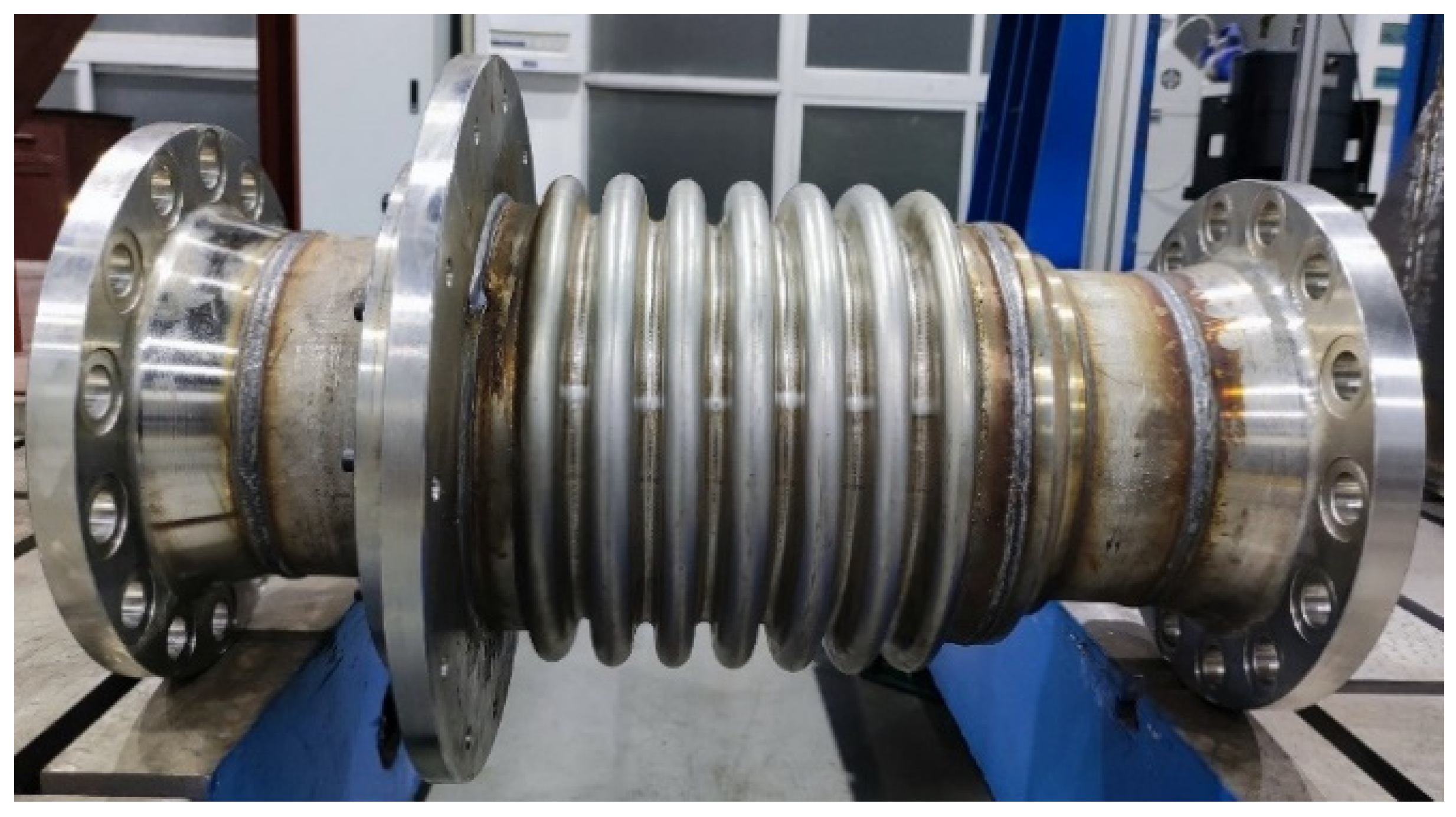
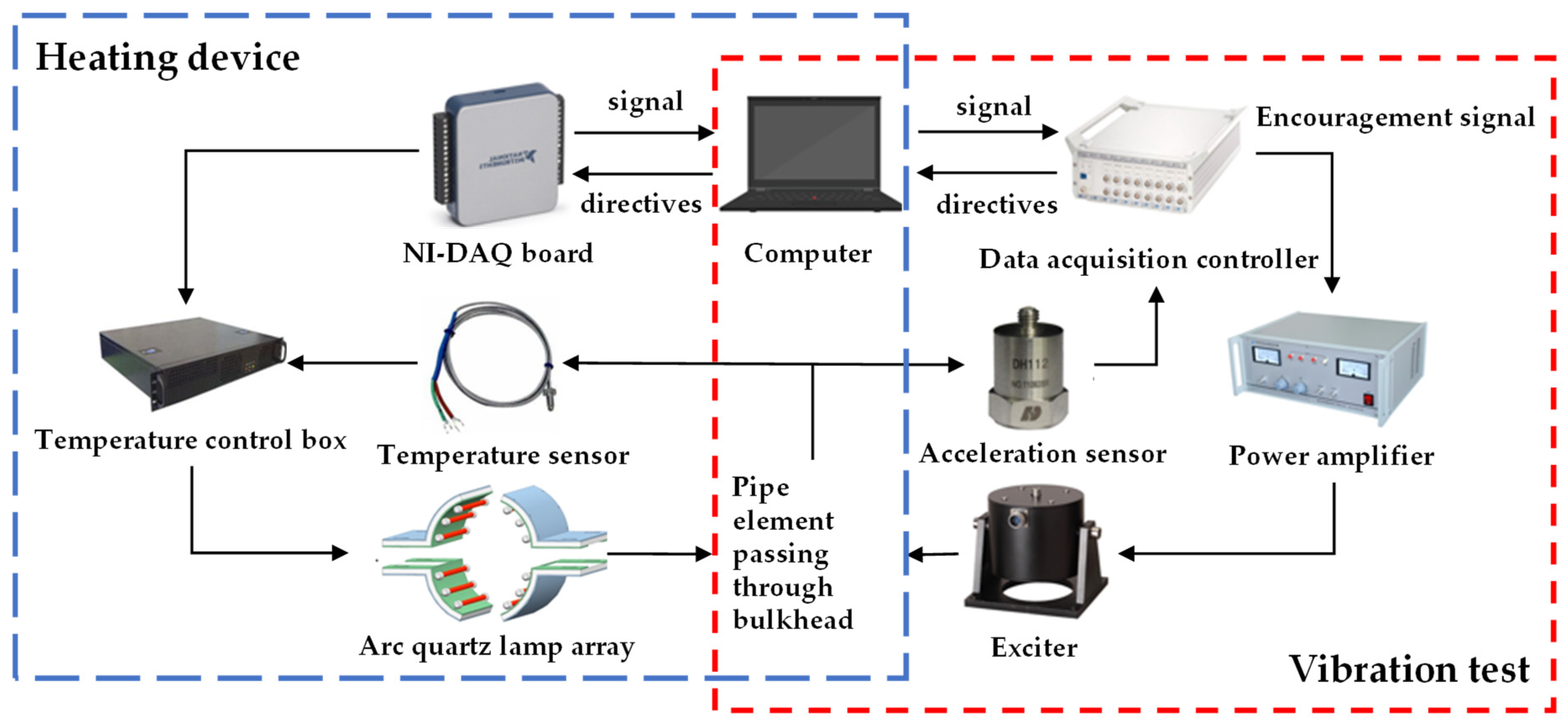
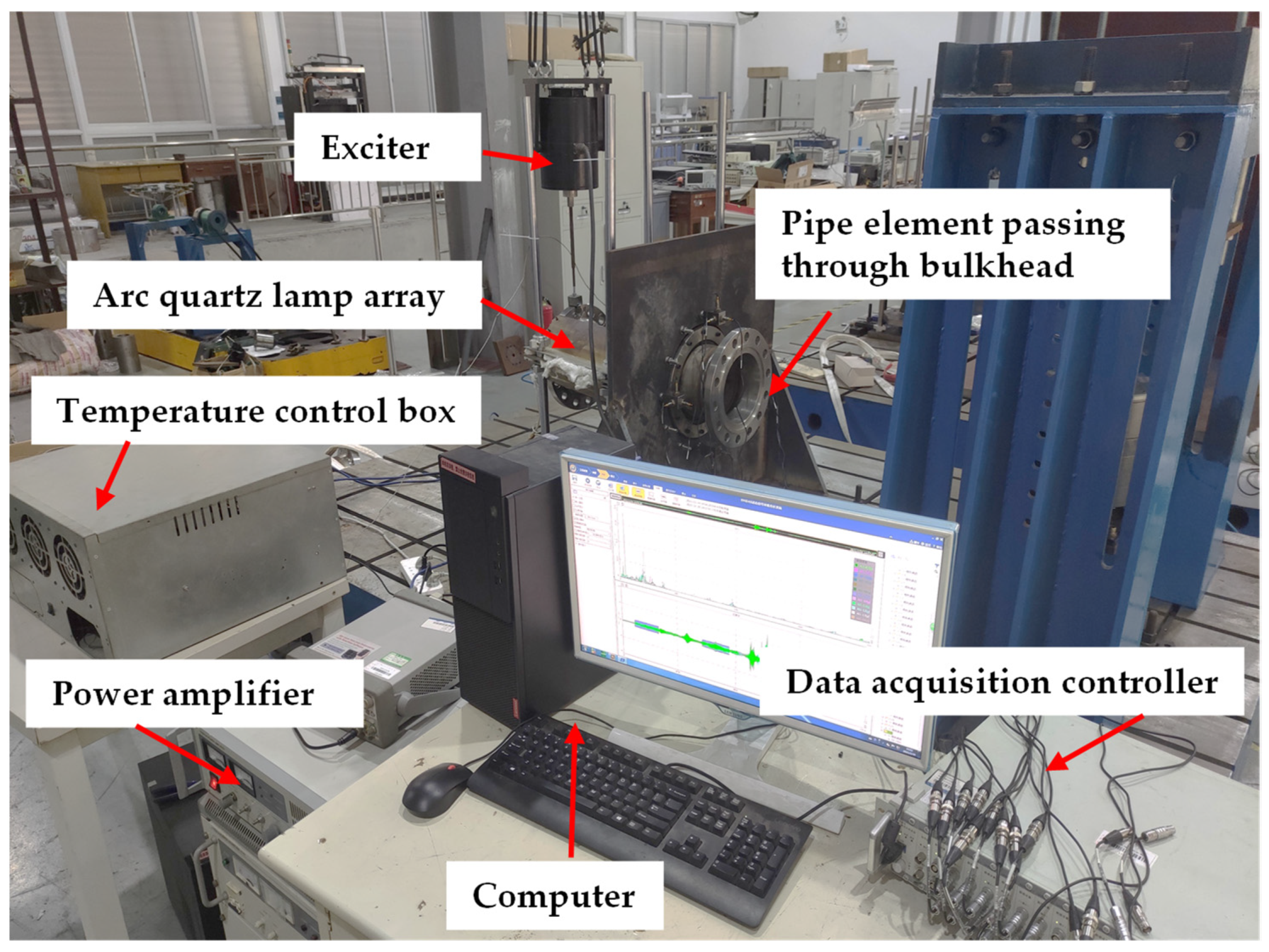
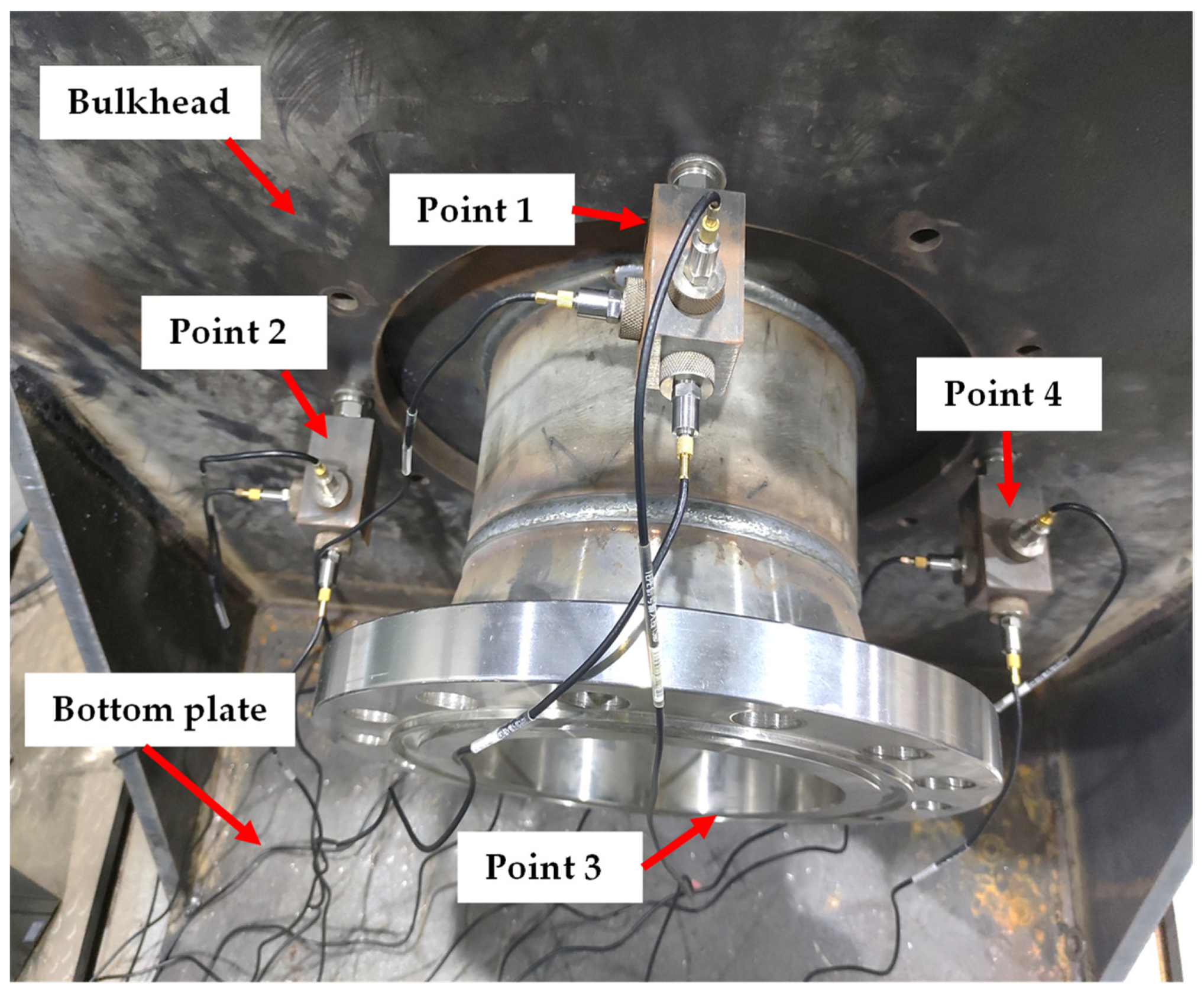



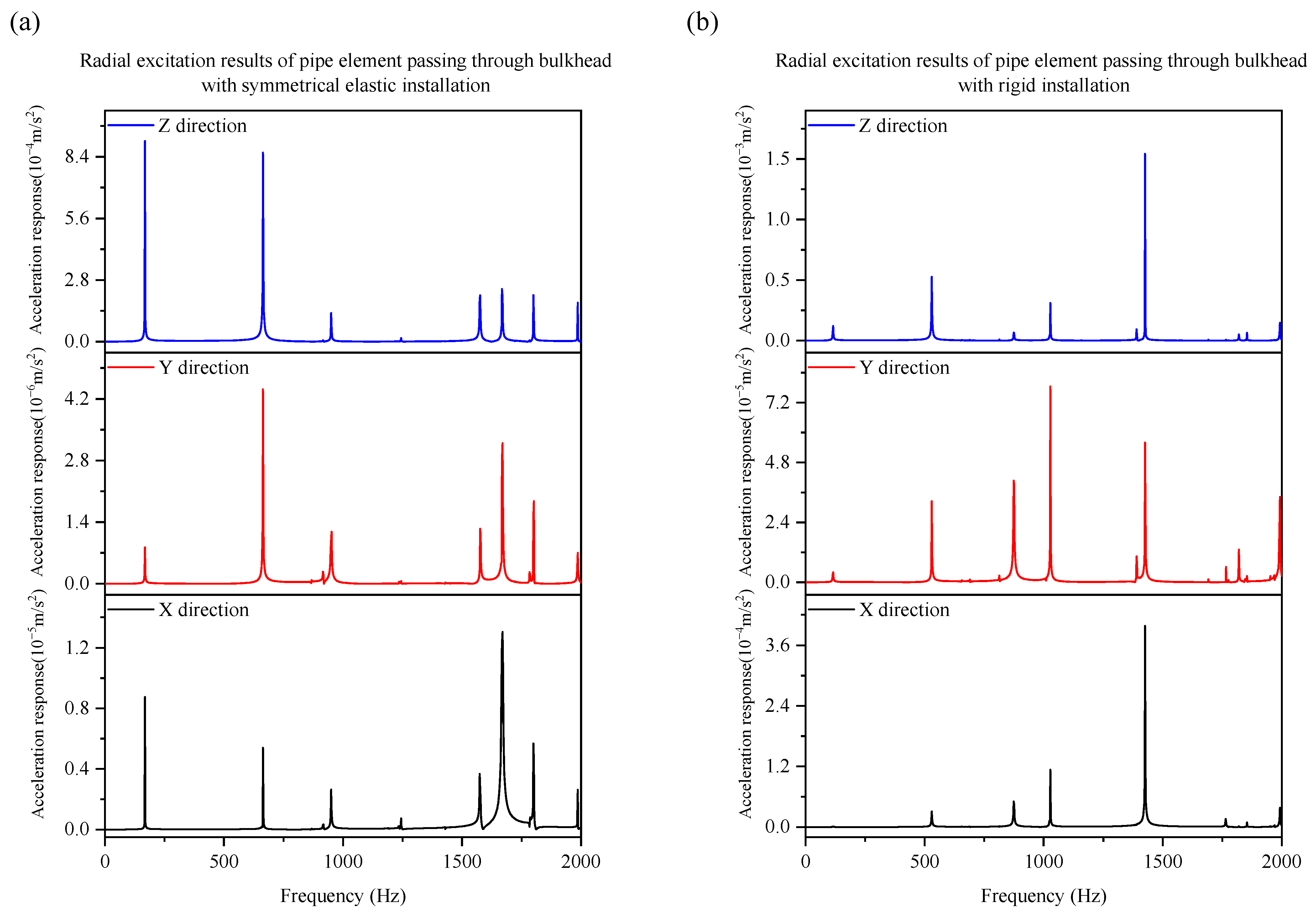
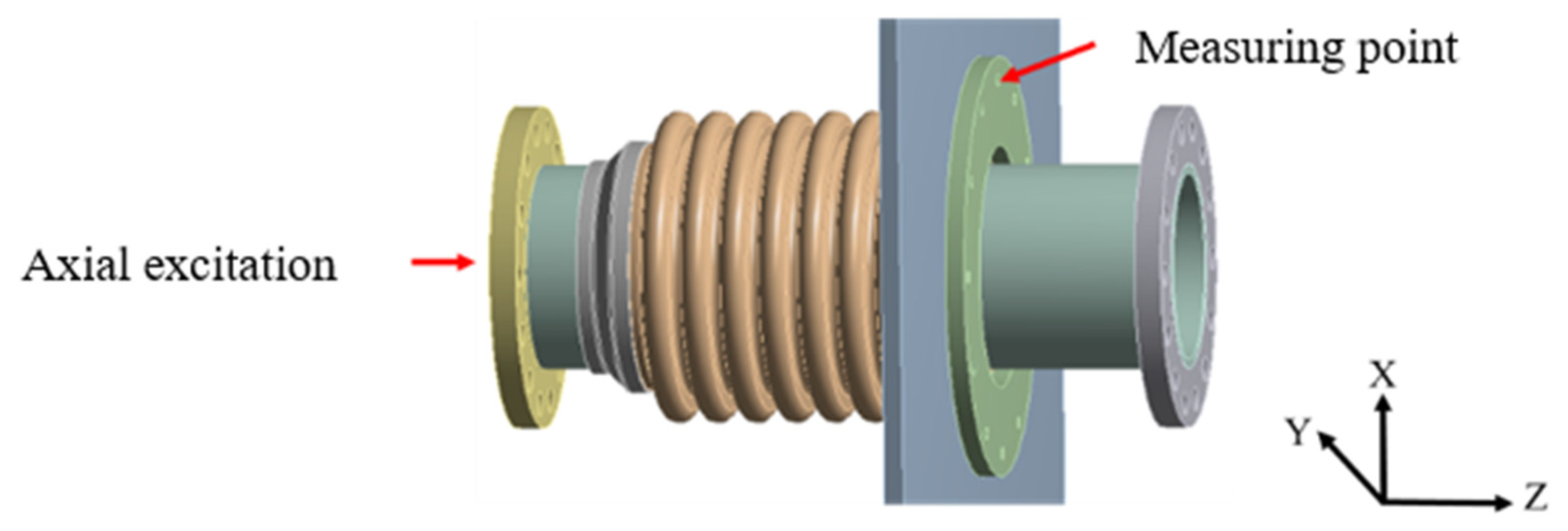

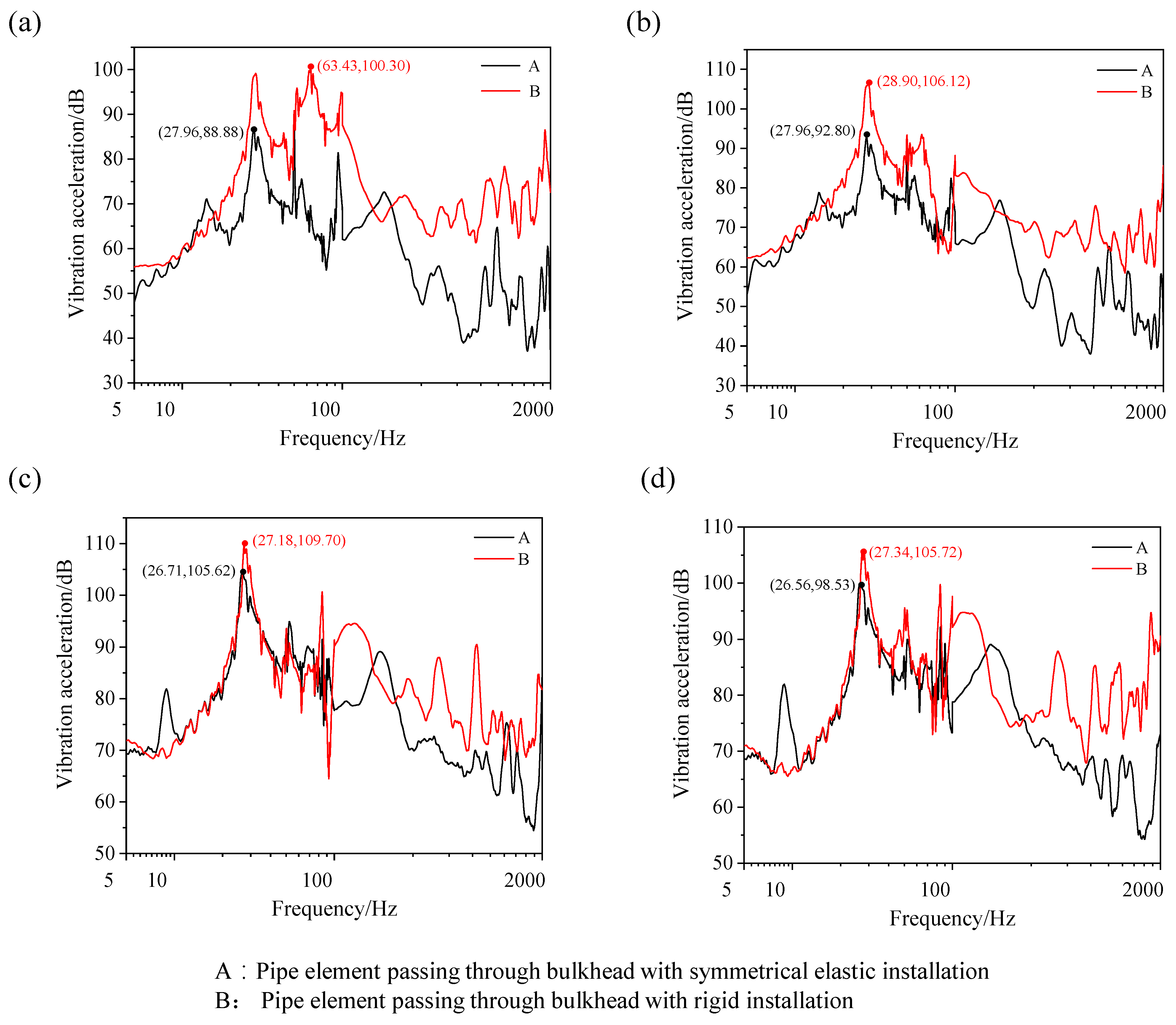
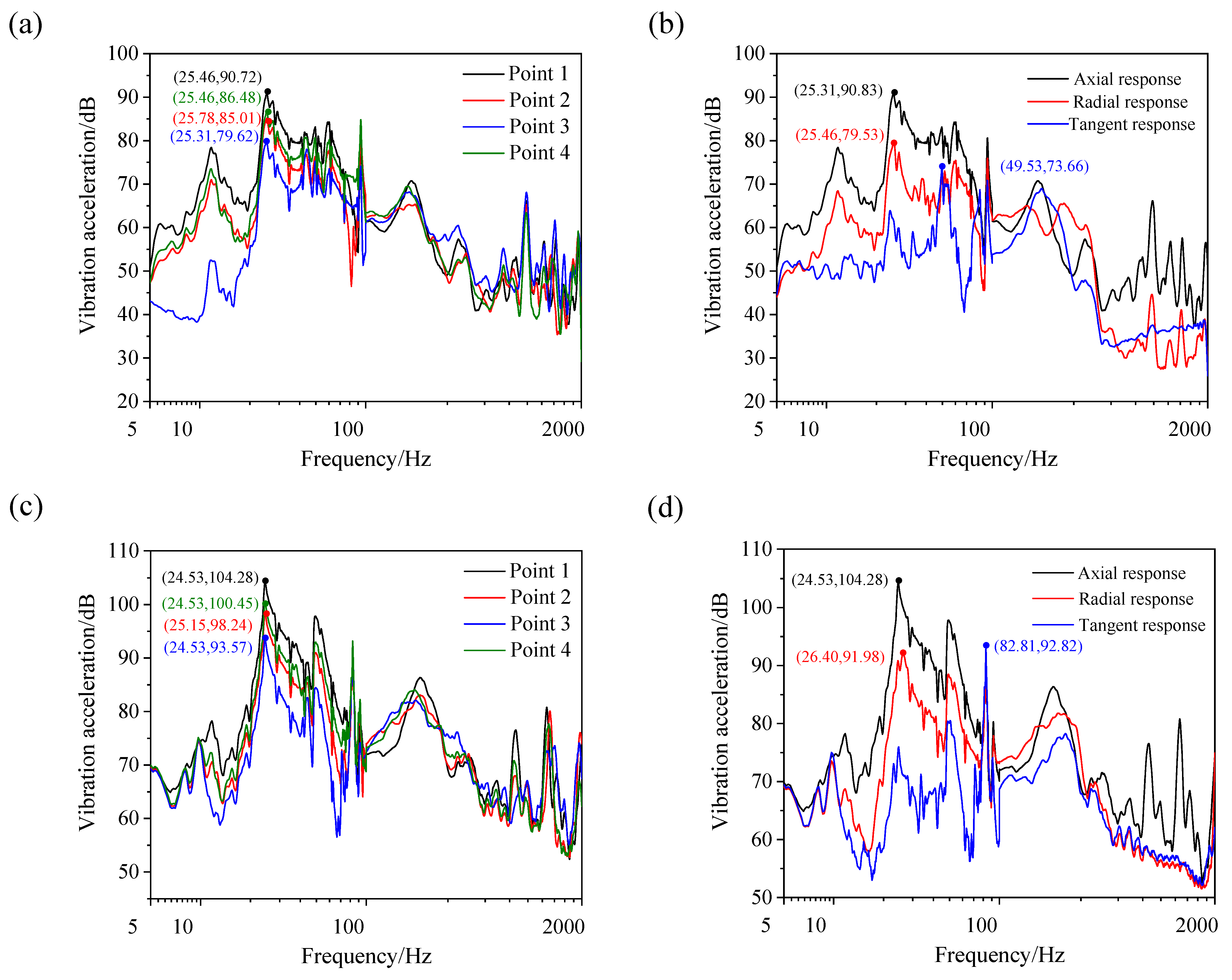


| Material | Elastic Modulus/Pa | Poisson’s Ratio | Density kg/m3 |
|---|---|---|---|
| 304 stainless steel | 2.04 × 1011 | 0.285 | 7.93 × 103 |
| C10 | C01 | D1 |
|---|---|---|
| 0.11 | 0.13 | 0.37 |
| Mode | 1 | 2 | 3 | 4 |
|---|---|---|---|---|
| Frequency/Hz | 160.4 | 723.2 | 905.7 | 1723.6 |
| Excitation Direction | X-Direction Response | Y-Direction Response | Z-Direction Response |
|---|---|---|---|
| Axial direction | 18.4 dB | 19.3 dB | 16.5 dB |
| Radial direction | 17.0 dB | 25.4 dB | 14.0 dB |
| Direction | RT (25 °C) | 100 °C | 200 °C | 300 °C |
|---|---|---|---|---|
| Radial direction | 23.0 | 23.4 | 22.5 | 22.4 |
| Axial direction | 15.7 | 14.1 | 13.8 | 12.9 |
| Direction | Point 1 Axial | Point 2 Axial | Point 3 Axial | Point 4 Axial | Point 1 Radial | Point 1 Tangent |
|---|---|---|---|---|---|---|
| Radial direction | 20.7 | 23.4 | 21.2 | 28.0 | 22.6 | 23.1 |
| Axial direction | 15.1 | 18.3 | 15.2 | 20.7 | 19.0 | 15.7 |
Publisher’s Note: MDPI stays neutral with regard to jurisdictional claims in published maps and institutional affiliations. |
© 2022 by the authors. Licensee MDPI, Basel, Switzerland. This article is an open access article distributed under the terms and conditions of the Creative Commons Attribution (CC BY) license (https://creativecommons.org/licenses/by/4.0/).
Share and Cite
Wu, Y.; Tang, Y.; Qin, Z.; Chen, X.; Bai, H. Experimental and Numerical Research on a Pipe Element Passing through Bulkhead with Symmetrical Elastic Installation. Symmetry 2022, 14, 453. https://doi.org/10.3390/sym14030453
Wu Y, Tang Y, Qin Z, Chen X, Bai H. Experimental and Numerical Research on a Pipe Element Passing through Bulkhead with Symmetrical Elastic Installation. Symmetry. 2022; 14(3):453. https://doi.org/10.3390/sym14030453
Chicago/Turabian StyleWu, Yiwan, Yu Tang, Zhiqiang Qin, Xiaochao Chen, and Hongbai Bai. 2022. "Experimental and Numerical Research on a Pipe Element Passing through Bulkhead with Symmetrical Elastic Installation" Symmetry 14, no. 3: 453. https://doi.org/10.3390/sym14030453






